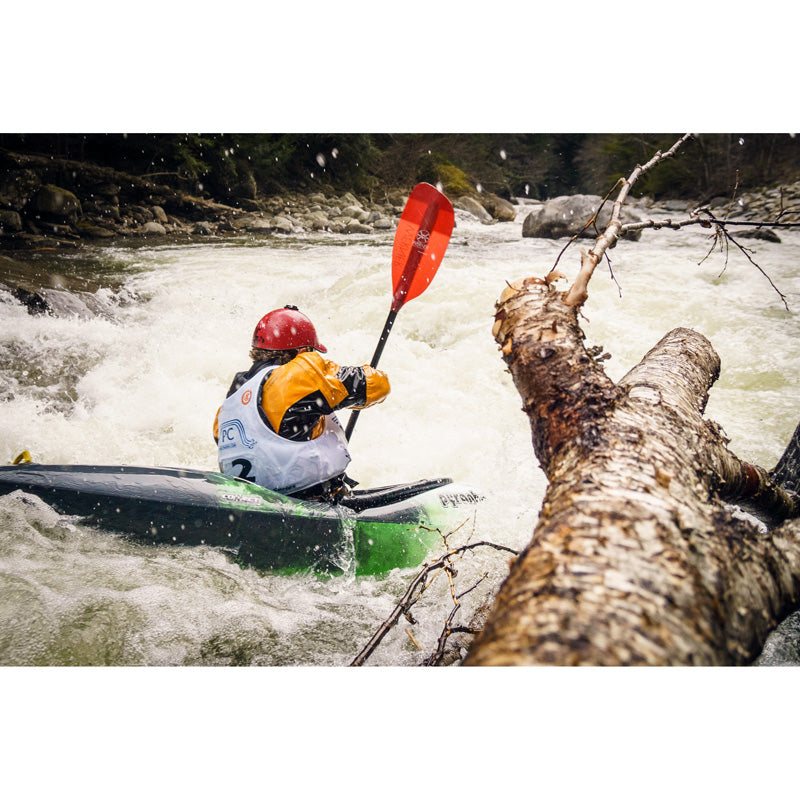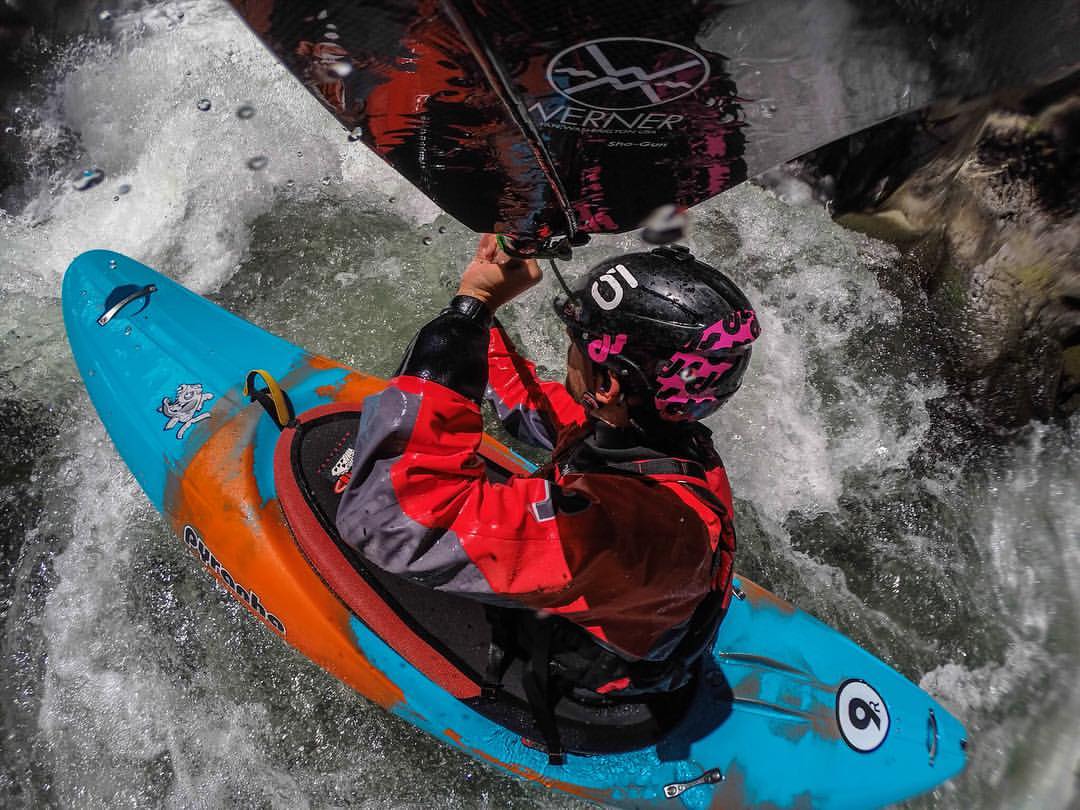 Foam Core vs. Fiberglass Whitewater Blades - by Nick Gottlieb
Foam Core vs. Fiberglass Whitewater Blades - by Nick Gottlieb
When I first started thinking about this review, it was going to be a review of the
Werner Stikine, a foam-core paddle. I’ve been using Werner foam-core blades for a long time (
Stikine and
Shogun) and had some ideas about what to say. I was going to tell you that the foam core adds flotation to the blade and claim that I like the way that paddles. About how the stiffness of the carbon exterior makes the blade more responsive. About how the weight is not a significant issue and is offset by the flotation in the blades.
Then, in the interest of making this a bit more valuable, I tried a fiberglass paddle (
Werner Powerhouse) and alternated between the two over the course of a couple weeks.
Turns out my original ideas were mostly wrong. We all get used to the gear we’re using, and it’s easy to convince yourself that your gear is the best, even going so far as to rationalize arguments about why that’s the case.
The truth is, there are pros and cons to everything and it’s important to keep an open mind.
Given that, here are some of the main differences I’ve found between my Werner Powerhouse and my Werner Stikine (both bent-shaft).

Eric Adsit at the 2015 New Haven Race, Bristol, Vermont.
Feel of the Blade in the Water
The two paddles are dramatically different in the water, but not for all the reasons I expected. The powerhouse blade is actually much more nimble, something I attribute mostly to the blade thickness. It’s easier to maneuver around in the water, making subtle draw-to-boof strokes and the like more effective. In general, it just feels much more responsive.
If that were the only difference, I’d have to go for the fiberglass blade every time, but it comes with a major fault as well, which is its lack of stiffness. It’s most noticeable when you hit a rock, but it’s actually noticeable even just taking strokes -- the blade flexes.
The foam-core carbon-coated blade of the Stikine does not flex. At all. Which also makes a big difference paddling; I personally really don’t like the feel of the blade flexing in the water. The flex also reduces efficiency (which is not a huge concern for most whitewater paddlers, but could be for folks interested in racing).
I found that the “flotation” of the foam core makes no difference in how it paddles. It’s unnoticeable when you use with the two blade styles side-by-side. Which is something, because I’ve been telling people about the benefits of the blade buoyancy for years...
 Weight
Weight
According to the Werner website, the two paddles are actually very close in weight. Both
bent-shaft, the Powerhouse comes in at 1070g and the
Stikine at 1042g (Shogun is 1091g). I don’t have an accurate enough scale to give real-world readings on these, so we’ll just have to trust Werner. The interesting thing is that despite the stated weight of the Stikine being lighter, I find that it feels like the heavier paddle. Without weighing the individual pieces of paddles to compare, I think the different feeling is attributable to a difference in weight distribution with the blades of the foam-core Stikine being heavier than those of the Powerhouse. I find that the weight distribution of the Powerhouse is easier to use and allows you to maintain a higher stroke rate with less fatigue.

Zach Schuster, Palguin
Durability
I unfortunately can’t provide anything beyond anecdotal information here, but what I’ve seen from sixteen years in the industry is that foam-core blades are quite durable -- until they aren’t. I’ve broken three over my paddling career, and I’ve seen plenty of others break. Generally, I get 2-3 years out of them (at 100+ days a year). Fiberglass blades, on the other hand, seem to break catastrophically less often (likely due to the flex), but whittle down over time. A three year old fiberglass blade looks more like a butter knife than a paddle. The foam-core blades do not whittle down, they just break.
 Conclusions
Conclusions
I love the lighter-weight feel, nimbleness, and price of the fiberglass blades, but for me, the stiffness of the foam-core blade is something I can’t live without. I’ve personally never paddled with a carbon-bladed Werner, but I think my next paddle will be the carbon Powerhouse. It’s lighter than both the foam-core and the fiberglass blades and seems like it would be the best of both worlds: stiff thanks to the carbon material but without the increased thickness or blade weight of the foam-core.
If you suffer from tendonitis or other issues (something I’ve dealt with in my elbows in the past), you may want to get a fiberglass paddle specifically because of the flexibility. It’s much better at absorbing in-water impacts; the stiff blade of the foam-core paddle transmits just transmits it up your arm.
I can’t speak directly about brands other than Werner, but most paddle companies seem to follow the same material conventions and I would imagine the same points apply just as well to other brands.

 Foam Core vs. Fiberglass Whitewater Blades - by Nick Gottlieb
When I first started thinking about this review, it was going to be a review of the Werner Stikine, a foam-core paddle. I’ve been using Werner foam-core blades for a long time (Stikine and Shogun) and had some ideas about what to say. I was going to tell you that the foam core adds flotation to the blade and claim that I like the way that paddles. About how the stiffness of the carbon exterior makes the blade more responsive. About how the weight is not a significant issue and is offset by the flotation in the blades.
Then, in the interest of making this a bit more valuable, I tried a fiberglass paddle (Werner Powerhouse) and alternated between the two over the course of a couple weeks.
Turns out my original ideas were mostly wrong. We all get used to the gear we’re using, and it’s easy to convince yourself that your gear is the best, even going so far as to rationalize arguments about why that’s the case. The truth is, there are pros and cons to everything and it’s important to keep an open mind.
Given that, here are some of the main differences I’ve found between my Werner Powerhouse and my Werner Stikine (both bent-shaft).
Foam Core vs. Fiberglass Whitewater Blades - by Nick Gottlieb
When I first started thinking about this review, it was going to be a review of the Werner Stikine, a foam-core paddle. I’ve been using Werner foam-core blades for a long time (Stikine and Shogun) and had some ideas about what to say. I was going to tell you that the foam core adds flotation to the blade and claim that I like the way that paddles. About how the stiffness of the carbon exterior makes the blade more responsive. About how the weight is not a significant issue and is offset by the flotation in the blades.
Then, in the interest of making this a bit more valuable, I tried a fiberglass paddle (Werner Powerhouse) and alternated between the two over the course of a couple weeks.
Turns out my original ideas were mostly wrong. We all get used to the gear we’re using, and it’s easy to convince yourself that your gear is the best, even going so far as to rationalize arguments about why that’s the case. The truth is, there are pros and cons to everything and it’s important to keep an open mind.
Given that, here are some of the main differences I’ve found between my Werner Powerhouse and my Werner Stikine (both bent-shaft).
 Eric Adsit at the 2015 New Haven Race, Bristol, Vermont.
Eric Adsit at the 2015 New Haven Race, Bristol, Vermont. Weight
According to the Werner website, the two paddles are actually very close in weight. Both bent-shaft, the Powerhouse comes in at 1070g and the Stikine at 1042g (Shogun is 1091g). I don’t have an accurate enough scale to give real-world readings on these, so we’ll just have to trust Werner. The interesting thing is that despite the stated weight of the Stikine being lighter, I find that it feels like the heavier paddle. Without weighing the individual pieces of paddles to compare, I think the different feeling is attributable to a difference in weight distribution with the blades of the foam-core Stikine being heavier than those of the Powerhouse. I find that the weight distribution of the Powerhouse is easier to use and allows you to maintain a higher stroke rate with less fatigue.
Weight
According to the Werner website, the two paddles are actually very close in weight. Both bent-shaft, the Powerhouse comes in at 1070g and the Stikine at 1042g (Shogun is 1091g). I don’t have an accurate enough scale to give real-world readings on these, so we’ll just have to trust Werner. The interesting thing is that despite the stated weight of the Stikine being lighter, I find that it feels like the heavier paddle. Without weighing the individual pieces of paddles to compare, I think the different feeling is attributable to a difference in weight distribution with the blades of the foam-core Stikine being heavier than those of the Powerhouse. I find that the weight distribution of the Powerhouse is easier to use and allows you to maintain a higher stroke rate with less fatigue.
 Zach Schuster, Palguin
Zach Schuster, Palguin Conclusions
I love the lighter-weight feel, nimbleness, and price of the fiberglass blades, but for me, the stiffness of the foam-core blade is something I can’t live without. I’ve personally never paddled with a carbon-bladed Werner, but I think my next paddle will be the carbon Powerhouse. It’s lighter than both the foam-core and the fiberglass blades and seems like it would be the best of both worlds: stiff thanks to the carbon material but without the increased thickness or blade weight of the foam-core.
If you suffer from tendonitis or other issues (something I’ve dealt with in my elbows in the past), you may want to get a fiberglass paddle specifically because of the flexibility. It’s much better at absorbing in-water impacts; the stiff blade of the foam-core paddle transmits just transmits it up your arm.
I can’t speak directly about brands other than Werner, but most paddle companies seem to follow the same material conventions and I would imagine the same points apply just as well to other brands.
Conclusions
I love the lighter-weight feel, nimbleness, and price of the fiberglass blades, but for me, the stiffness of the foam-core blade is something I can’t live without. I’ve personally never paddled with a carbon-bladed Werner, but I think my next paddle will be the carbon Powerhouse. It’s lighter than both the foam-core and the fiberglass blades and seems like it would be the best of both worlds: stiff thanks to the carbon material but without the increased thickness or blade weight of the foam-core.
If you suffer from tendonitis or other issues (something I’ve dealt with in my elbows in the past), you may want to get a fiberglass paddle specifically because of the flexibility. It’s much better at absorbing in-water impacts; the stiff blade of the foam-core paddle transmits just transmits it up your arm.
I can’t speak directly about brands other than Werner, but most paddle companies seem to follow the same material conventions and I would imagine the same points apply just as well to other brands.





